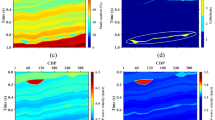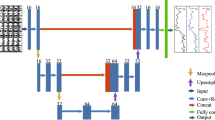Abstract
Traditional deep learning methods pursue complex and single network architectures without considering the petrophysical relationship between different elastic parameters. The mathematical and statistical significance of the inversion results may lead to model overfitting, especially when there are a limited number of well logs in a working area. Multitask learning provides an effective approach to addressing this issue. Simultaneously, learning multiple related tasks can improve a model’s generalization ability to a certain extent, thereby enhancing the performance of related tasks with an equal amount of labeled data. In this study, we propose an end-to-end multitask deep learning model that integrates a fully convolutional network and bidirectional gated recurrent unit for intelligent prestack inversion of “seismic data to elastic parameters.” The use of a Bayesian homoscedastic uncertainty-based loss function enables adaptive learning of the weight coefficients for different elastic parameter inversion tasks, thereby reducing uncertainty during the inversion process. The proposed method combines the local feature perception of convolutional neural networks with the long-term memory of bidirectional gated recurrent networks. It maintains the rock physics constraint relationships among different elastic parameters during the inversion process, demonstrating a high level of prediction accuracy. Numerical simulations and processing results of real seismic data validate the effectiveness and practicality of the proposed method.
Similar content being viewed by others
References
Abu-Mostafa Y S. Learning from hints in neural networks[J]. Journal of complexity, 1990, 6(2): 192–198.
Yuan S, Liu J, Wang S, et al. Seismic waveform classification and first-break picking using convolution neural networks[J]. IEEE Geoscience and Remote Sensing Letters, 2018, 15(2): 272–276.
Wang J, Xiao Z, Liu C, et al. Deep learning for picking seismic arrival times[J]. Journal of Geophysical Research: Solid Earth, 2019, 124(7): 6612–6624.
Yang F, Ma J. Deep-learning inversion: A next-generation seismic velocity model building method DL for velocity model building[J]. Geophysics, 2019, 84(4): R583–R599.
Araya-Polo M, Jennings J, Adler A, et al. Deep-learning tomography[J]. The Leading Edge, 2018, 37(1): 58–66.
Qian F, Yin M, Liu X Y, et al. Unsupervised seismic facies analysis via deep convolutional autoencoders[J]. Geophysics, 2018, 83(3): A39–A43.
He S, Song Z, Zhang M, et al. Incremental semi-supervised learning for intelligent seismic facies identification[J]. Applied Geophysics, 2022, 19(1): 41–52.
Huang L, Dong X, Clee T E. A scalable deep learning platform for identifying geologic features from seismic attributes[J]. The Leading Edge, 2017, 36(3): 249–256.
Wu X, Liang L, Shi Y, et al. FaultSeg3D: Using synthetic data sets to train an end-to-end convolutional neural network for 3D seismic fault segmentation[J]. Geophysics, 2019, 84(3): IM35–IM45.
Das V, Pollack A, Wollner U, et al. Convolutional neural network for seismic impedance inversion[J]. Geophysics, 2019, 84(6): R869–R880.
Yuan S, Jiao X, Luo Y, et al. Double-scale supervised inversion with a data-driven forward model for low-frequency impedance recovery[J]. Geophysics, 2022, 87(2): R165–R181.
Yuan S, Wang S, Luo Y, et al. Impedance inversion by using the low-frequency full-waveform inversion result as an a priori model[J]. Geophysics, 2019, 84(2): R149–R164.
Sang W, Yuan S, Han H, et al. Porosity prediction using semi-supervised learning with biased well log data for improving estimation accuracy and reducing prediction uncertainty[J]. Geophysical Journal International, 2023, 232(2): 940–957.
Cui R, Cao D, Liu Q, et al. VP and VS prediction from digital rock images using a combination of U-Net and convolutional neural networks Velocity prediction from digital rock by DL[J]. Geophysics, 2021, 86(1): MR27–MR37.
Biswas R, Sen M K, Das V, et al. Prestack and poststack inversion using a physics-guided convolutional neural network[J]. Interpretation, 2019, 7(3): SE161–SE174.
Du J, Liu J, Zhang G, et al. Pre-stack seismic inversion using SeisInv-ResNet[M]//SEG Technical Program Expanded Abstracts 2019. Society of Exploration Geophysicists, 2019: 2338–2342.
Sun Y, Liu Y, Zhang M, et al. Inversion of low-to medium-frequency velocities and densities from AVO data using invertible neural networks[J]. Geophysics, 2022, 87(3): A37–A42.
Cao D, Su Y, Cui R. Multi-parameter pre-stack seismic inversion based on deep learning with sparse reflection coefficient constraints[J]. Journal of Petroleum Science and Engineering, 2022, 209: 109836.
Kendall A, Gal Y, Cipolla R. Multi-task learning using uncertainty to weigh losses for scene geometry and semantics[C]//Proceedings of the IEEE conference on computer vision and pattern recognition. 2018: 7482–7491.
Aki K, Richards P G. Quantitative seismology[M]. 2002.
Author information
Authors and Affiliations
Corresponding author
Additional information
This work was supported by National Key R & D Program of China(2018YFA0702501), National Natural Science Foundation of China (41974140), Science and Technology Management Department, China National Petroleum Corporation (2022DQ0604-01), China National Petroleum Corporation - China University of Petroleum (Beijing) Strategy.
Cheng Jian-yong received a bachelor’s degree in surveying and prospecting technology and engineering from Yangtze University, Hubei, China, in 2020 and received a master’s degree in geological resources and geological engineering from China University of Petroleum-Beijing, Beijing, China, in 2023. His research interests include artificial intelligence and reservoir prediction.
E-mail: 17371273547@163.com.
Rights and permissions
About this article
Cite this article
Cheng, Jy., Yuan, Sy., Sun, Ax. et al. Multitask Weighted Adaptive Prestack Seismic Inversion. Appl. Geophys. (2024). https://doi.org/10.1007/s11770-024-1082-y
Received:
Revised:
Published:
DOI: https://doi.org/10.1007/s11770-024-1082-y




